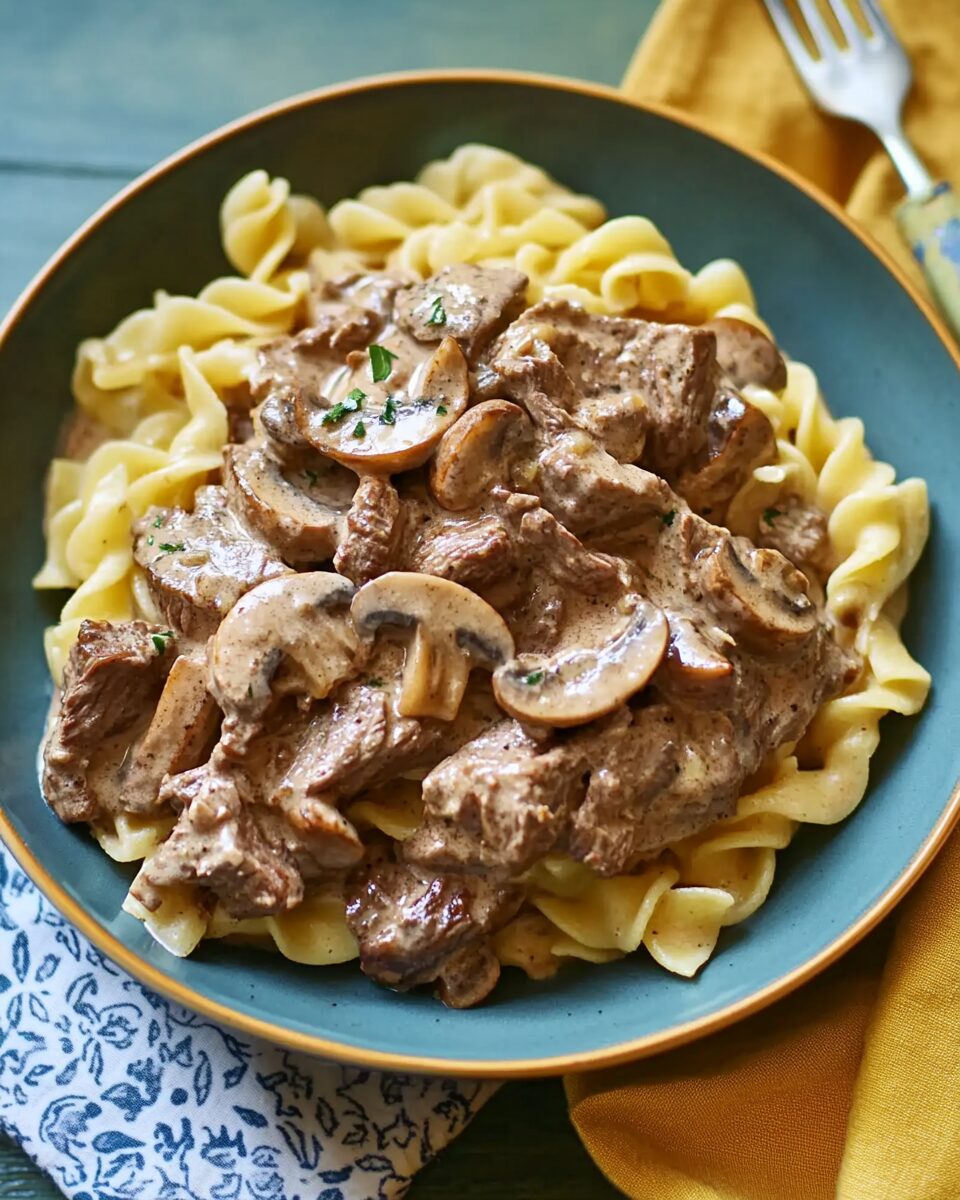Why This Recipe Works
This Stroganoff recipe honors tradition while making a few practical adjustments for modern kitchens. It works beautifully thanks to thoughtful choices in technique and ingredient balance:
Using top sirloin or tenderloin, seared quickly at high heat, ensures the beef stays tender and juicy.
Butter enhances richness and depth, while providing the perfect base for sautéing the aromatics.
Shallots (or onions) bring sweetness and complexity that builds a flavorful foundation.
Cremini mushrooms offer umami and a satisfying chew, giving the dish heartiness and balance.
Nutmeg and tarragon add subtle warmth and herbal brightness, elevating the creamy sauce with unexpected depth.
The sour cream, added off the heat, keeps the sauce smooth and tangy without curdling—creating the signature velvety texture Stroganoff is known for.
This version also uses just enough sour cream to keep the dish creamy without overwhelming the other ingredients. It’s a dish that builds flavor in layers—meat, aromatics, mushrooms, sauce—and comes together seamlessly at the end for a luxurious, cohesive finish.
Flavor and Texture Highlights
Beef Stroganoff is defined by its velvety, savory cream sauce, but it’s the contrast and layering of flavors and textures that make it truly memorable:
Seared beef adds meaty richness and a satisfying bite.
Shallots or onions infuse a mild, sweet allium undertone.
Mushrooms bring depth and earthiness, absorbing and enriching the sauce.
Butter and sour cream contribute a creamy mouthfeel and tangy richness.
Nutmeg and tarragon introduce subtle spice and herbal brightness.
Salt and freshly cracked black pepper balance everything out.
Each element is distinct, yet they blend into a sauce that’s complex, warming, and irresistible—especially when spooned over noodles or fluffy mashed potatoes.
Cultural Origins and Legacy
Beef Stroganoff dates back to 19th-century Russia, where it was named after the aristocratic Stroganov family. Originally a dish that paired sautéed beef cubes with a mustard- and broth-based cream sauce, it evolved over time to include mushrooms, onions, and sour cream—reflecting both French culinary influence and local tastes.
As Stroganoff gained popularity beyond Russia, especially during the 20th century, it became a fixture in European and American households. Each region added its own twist—some with wine, others with Worcestershire sauce, or even cream of mushroom soup in mid-century adaptations.
Today, it’s a globally beloved dish that manages to feel both retro and timeless, and this version sticks to its roots of high-quality beef, fresh mushrooms, and a silky sour cream sauce—with a modern appreciation for flavor and technique.
Nutritional Highlights (Per Serving – Serves 4)
This dish is indulgent but also offers solid nutritional value when balanced with sides like vegetables or whole grains:
Calories: 634
Fat: 54g
Saturated Fat: 26g
Cholesterol: 168mg
Sodium: 347mg
Carbohydrates: 8g
Dietary Fiber: 1g
Sugars: 4g
Protein: 31g
Vitamin C: 2mg (9%)
Calcium: 93mg (7%)
Iron: 4mg (23%)
Potassium: 769mg (16%)
With over 30 grams of protein per serving, Beef Stroganoff is a substantial main course. To lighten it, you can opt for reduced-fat sour cream, use less butter, or substitute some of the beef with mushrooms or tofu for a more balanced macronutrient profile.
Tips for Best Results
Use room temperature sour cream to prevent curdling when it’s added to the hot pan.
Slice the beef against the grain and as thinly as possible for tenderness.
Don’t overcrowd the pan when searing—brown the meat in batches for a proper crust.
If you prefer a thinner sauce, stir in a few tablespoons of beef stock or water with the sour cream.
Do not boil the sour cream—heat it gently or it may separate and ruin the sauce texture.
You can substitute Greek yogurt or crème fraîche if you prefer a different tang or lighter option.
Serving Suggestions
Beef Stroganoff is incredibly versatile in how it can be served:
Egg noodles are the classic choice—their broad, soft texture cradles the creamy sauce beautifully.
Mashed potatoes offer extra comfort and absorb the sauce luxuriously.
Steamed white rice provides a clean base and works well for gluten-free diets.
Buttered pasta or even polenta can also make an excellent pairing.
Add a side of roasted green beans, glazed carrots, or steamed broccoli for color and balance.
For a complete meal, serve with a light salad and a glass of dry red wine or a chilled lager.
Make-Ahead and Storage Tips
This dish can be prepared in stages or ahead of time:
Brown the meat and sauté the mushrooms and shallots in advance—store in the fridge for up to 2 days.
The full dish can be assembled and gently reheated, though it’s best to reheat over low heat to avoid splitting the sour cream.
Store leftovers in an airtight container for up to 3 days.
Freezing is not recommended as the sour cream can separate when thawed, but you can freeze the beef and mushroom base (without sour cream) and add it fresh upon reheating.
Why You’ll Love This Recipe
You’ll fall for Beef Stroganoff for its comforting richness, satisfying texture, and nostalgic charm. It’s:
Simple enough for a weeknight
Elegant enough for guests or date night
Customizable with meat substitutions or vegetarian variations
Made with one skillet and minimal prep
Elevated with just a few thoughtful ingredients like nutmeg and tarragon
It’s the kind of dish that warms you from the inside out—and becomes a go-to recipe for years to come.
Conclusion
Beef Stroganoff is a timeless classic that brings together tender meat, earthy mushrooms, and creamy sauce in a dish that feels as cozy as it does luxurious. With its simple ingredients and quick preparation, it’s perfect for everything from casual dinners to festive meals, and it can be tailored to suit any taste or dietary need. Once you make this comforting favorite from scratch, you’ll understand why it remains a beloved staple in kitchens around the world.






